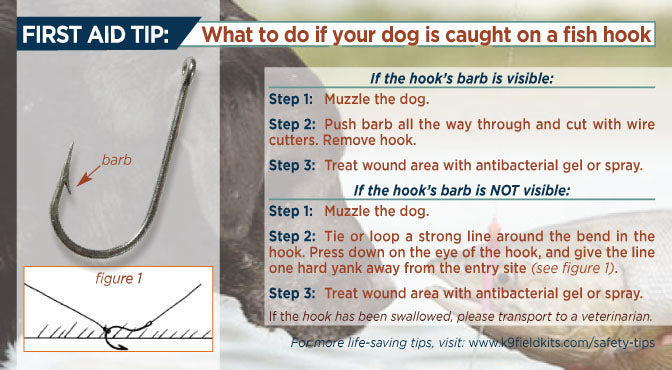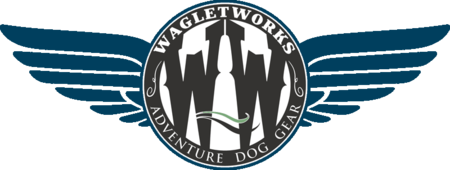Since the dawn of mankind, fishing has alway been a great bonding activity and a fantastic way to spend some quality time with your canine companion. However, a miscast line, carelessness on your part, or the too-tempting lure (pun intended) of something shiny can be too much temptation for a curious pooch, resulting in a fish hook injury. The most common of these injuries is a dog being hooked in the mouth, lips or body. Below are the steps to follow if this occurs.
Important note: If the hook enters the eye or surrounding tissue, DO NOT attempt to remove, as any attempt may lead to a more serious injury, including potential blindness and/or the loss of the eye. Loosely cover the injured eye and transport immediately to a veterinarian (or if possible, a veterinary opthamologist).
[caption id="attachment_6" align="aligncenter" width="640"] right click to download | ©2013 K9 Field Kits, Inc.[/caption]
right click to download | ©2013 K9 Field Kits, Inc.[/caption]
If the hook's barb is visible, follow these steps:
Step 1: Muzzle the dog. These injuries are often extremely painful and can often lead to fear-biting.
Step 2: Expose the barb by pushing the barb all of the way through. Cut the barb with wire cutters and remove the hook.
Step 3: Treat the wounded area with an antibacterial gel or spray.
If the hook's barb is NOT visible, follow these steps:
Step 1: Muzzle the dog.
Step 2: Tie or loop a strong line around the bend in the hook. Press down on the eye of the hook, and give the line one hard yank away from the entry site (see figure 1 below).
[caption id="attachment_4" align="aligncenter" width="234"] figure 1[/caption]
figure 1[/caption]
Step 3: Treat the wounded area with an antibacterial gel or spray. Have the wound examined by a veterinarian as soon as possible.
If the hook has been swallowed, and immediate veterinary care is not possible, follow these steps:
Step 1: Cut the line. DO NOT pull or tug the line, as this may set the hook and possibly tear the esophagus and/or stomach.
Step 2: Feed the dog bread to help dislodge the obstruction and hopefully coat the object as passes through the digestive system.
Step 3: Monitor the dog for signs of peritonitis (high fever - 103 degrees or above, abdominal pain or bloat, blood in vomit, "coffee grounds" in vomit - may indicate stomach bleeding, dehydration). If any of these symptoms appear, it is imperative to get to a veterinarian as soon as possible, as these symptoms are life-threatening in a very short time.
Step 4: Transport the dog to veterinarian as soon as possible (even if there are no signs of peritonitis), as surgery may be required.
To view more life-saving tips, visit: www.k9fieldkits.com/safety-tips
Pet First Aid Kits are available here: www.k9fieldkits.com/purchase-kits
If you have any fish hook stories you want to share, hit us up in the comments section below!

